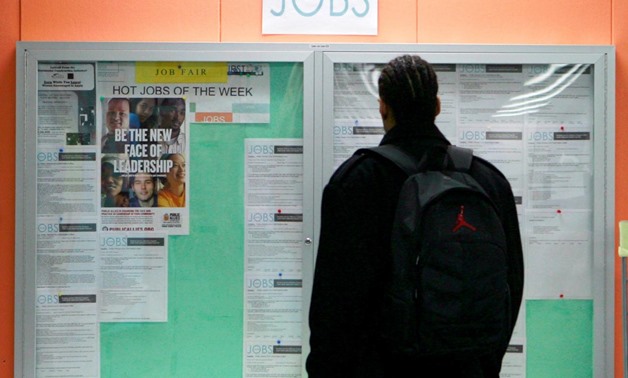
FILE PHOTO: A man looks over employment opportunities at a jobs center in San Francisco, California, U.S, February 4, 2010. REUTERS/Robert Galbraith/File Photo
WASHINGTON - 21 September 2017: The number of Americans filing for unemployment benefits unexpectedly fell last week, but the near-term outlook for the labor market was muddied by the continuing impact of Hurricanes Harvey and Irma.
Other data on Thursday showed manufacturing activity in the mid-Atlantic region accelerated in September amid a surge in new orders. But hiring by factories slowed and employees worked fewer hours this month compared to August.
Initial claims for state unemployment benefits declined 23,000 to a seasonally adjusted 259,000 for the week ended Sept. 16, the Labor Department said. A Labor Department official said Harvey and Irma affected claims for Texas and Florida.
Unadjusted claims for Texas fell 23,549 last week, the second straight weekly drop. Claims in Texas surged in the wake of Harvey, which disrupted oil, natural gas and petrochemicals production, leaving some workers temporarily unemployed.
Unadjusted claims for Florida rose 5,133 last week. In addition, the Labor Department estimated claims for South Carolina and the Virgin Islands last week.
Economists had forecast claims rising to 300,000 in the latest week. It was the 133rd straight week that claims remained below the 300,000 threshold, which is associated with a robust labor market. That is the longest such stretch since 1970, when the labor market was smaller.
The four-week moving average of claims, considered a better measure of labor market trends as it irons out week-to-week volatility, rose 6,000 to 268,750 last week.
Prices of U.S. Treasuries pared gains after the data and the dollar was weaker against a basket of currencies. U.S. stock index futures were trading lower.
The claims data covered the survey period for the non-farm payrolls portion of September's employment report. There are fears the disruption caused by Harvey and Irma could restrain job growth in September. Texas and Florida account for about 14 percent of U.S. employment.
Federal Reserve Chair Janet Yellen told reporters on Wednesday that "payroll employment may be substantially affected in September" by the storms, but she added that she expected labor market conditions would strengthen somewhat further out.
Yellen made the comments after the U.S. central bank left interest rates unchanged but signaled it still anticipated one more rate increase by the end of the year.
The four-week moving average of claims rose 28,250 between the August and September survey periods, suggesting a further slowdown in job growth. The economy added 156,000 jobs in August, with the private services sector hiring the smallest number of workers in five months.
In a separate report on Thursday, the Philadelphia Fed said its manufacturing activity index for the mid-Atlantic region increased about 5 points to a reading of 23.8 in September. It said almost 39 percent of the firms indicated increases in activity this month while 15 percent reported a decrease.
Firms reported a jump in new orders. The survey's employment index fell to a reading of 6.6, but has remained positive for 10 consecutive months. A measure of the average workweek dropped to a reading of 11.9 from 18.8 in August.


Comments
Leave a Comment